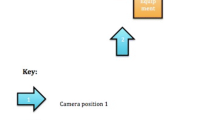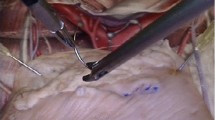Abstract
Background: Laparoscopic suturing is technically a demanding skill in laparoscopic surgery. Ergonomic experimental studies provide objective information on the important factors and variables that govern optimal endoscopic suturing. Our objective was to determine the optimum physical alignment, visual display, and direction of intracorporeal laparoscopic bowel suturing using infrared motion analysis and telemetric electromyography (EMG) systems. Methods: Ten surgeons participated in the study; each sutured 50-mm porcine small bowel enterotomies toward and away from the surgeon in the vertical and horizontal bowel plane with either isoplanar (image display corresponds with actual lie of the bowel) or nonisoplanar (bowel displayed horizontally but mounted vertically in the trainer and vice versa) display. The end points were the placement error score, execution time, leakage pressure, motion analysis, and telemetric EMG parameters of the surgeon's dominant upper limb. Results: Suturing was demonstrably easier in the vertical than in the horizontal plane, resulting in a better task quality (placement error score, p < 0.0001; leakage pressure, p < 0.005) and shorter execution time (p < 0.05). Nonisoplanar display of the surgical anatomy degrades performance in terms of both task efficiency and task quality. On motion analysis, a wider angle of excursion and lower angular velocity were observed during the vertical suturing with isoplaner display. Compared to horizontal suturing, supination at the wrist was significantly greater during vertical than horizontal suturing (p < 0.05). Within each category (vertical vs horizontal suturing), the direction of suturing (toward/away from the surgeon) did not influence the extent of pronation/ supination at the wrist. In line with the degraded performance, significantly more muscle work was expended during horizontal suturing. This affected the forearm flexors (p < 0.05), arm flexors and extensors (p < 0.005 and p < 0.05, respectively), and deltoid muscles (p < 0.005) and was accompanied by significantly more fatigue in the related muscles. Small bowel enterotomies sutured toward the surgeon in both the vertical and the horizontal planes exhibited less placement error score than when sutured away from the surgeon, with no significant difference in the motion analysis and EMG parameters. Conclusions: Optimal laparoscopic suturing (better task quality and reduced execution time) is achieved with vertical suturing toward the surgeon with isoplanar monitor display of the operative field. The poorer task performance observed during horizontal suturing is accompanied by more muscle work and fatigue, and it is not improved by monitor display of the enterotomy in the vertical plane.
Similar content being viewed by others
Author information
Authors and Affiliations
Rights and permissions
About this article
Cite this article
Emam, T., Hanna, G. & Cuschieri, A. Ergonomic principles of task alignment, visual display, and direction of execution of laparoscopic bowel suturing. Surg Endosc 16, 267–271 (2002). https://doi.org/10.1007/s00464-001-8152-4
Received:
Accepted:
Published:
Issue Date:
DOI: https://doi.org/10.1007/s00464-001-8152-4




